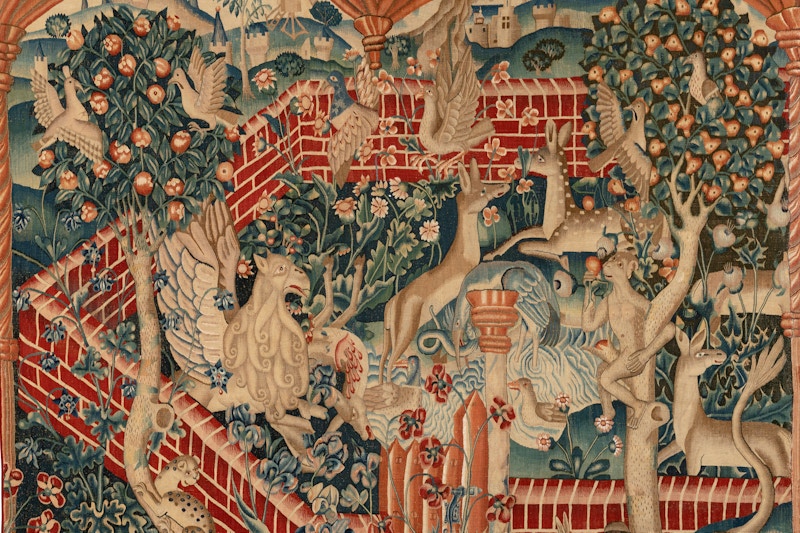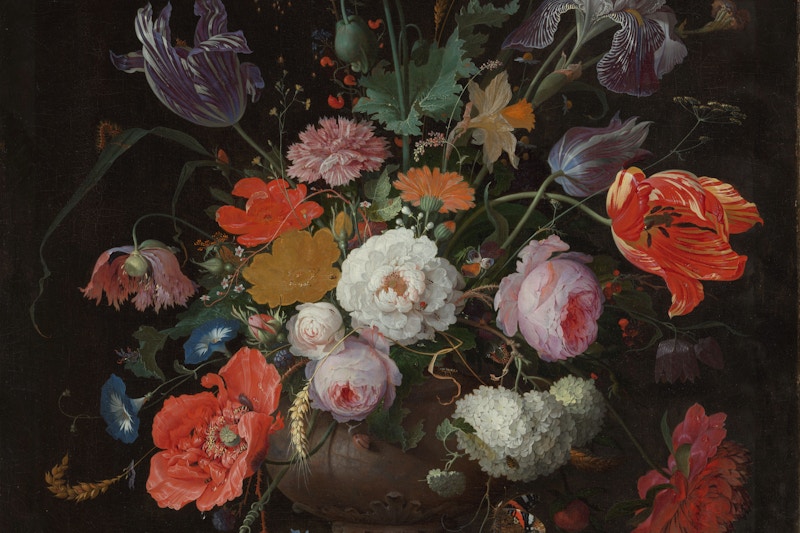
Detail of English School, Elizabeth I, 1533-1603 (the “Armada Portrait”), c. 1588. National Maritime Museum, Greenwich, London. Acquired with the support of the Heritage Lottery Fund, Art Fund, Linbury Trust, Garfield Weston Foundation, Headley Trust and other major donors, together with contributions from over 8,000 members of the public following a joint appeal with Art Fund.
The Power of the Pearl and Its Enduring Allure
Adorning wearers from the ancient Romans to Queen Victoria, the pearl remains the longest consistently venerated gemstone
- By Stephanie Sporn
- Meet the Experts
Jewelry connoisseurs will certainly be acquainted with the fabled transaction behind Cartier’s Fifth Avenue mansion—in 1917, Pierre Cartier traded a double-stranded, natural pearl necklace valued at the time for $1 million, and $100 in cash for the building, which still operates as the house’s New York City flagship. But when did the notion of pearls as a precious commodity begin? It is a question that jewelry and art historian Beatriz Chadour-Sampson has painstakingly explored, chiefly with the 2013 Victoria & Albert Museum exhibition Pearls, which she co-curated with the late Qatar Museum Authority curator, Hubert Bari, and their book of the same name.
“As far back as 70,000-100,000 BC, women were wearing shells as a symbol of fertility—but when and how does the pearl inside the shell become the jewel?” asks Chadour-Sampson, who serves as a senior specialist expert for jewelry at Les Enluminures, a gallery specializing in manuscripts and historic jewelry from the Middle Ages and the Renaissance. According to Chadour-Sampson, the pearl trade dates to about 1,000 BC and was concentrated in the Persian Gulf. The Epic of Gilgamesh even describes a “flower coming out of the sea,” which, says Chadour-Sampson, is “undoubtedly a reference to the pearl.” Iran, Mesopotamia, India, Ceylon (now Sri Lanka), and China were among the earliest points of trade, and it was through Alexander the Great that the gemstone traveled to the West by way of Greece.
“It is very rare that pearls from these periods survive because they are living creatures that breathe and need moisture. Without proper care, they will lose their luster and die,” Chadour-Sampson explains. But even without a surplus of extant pearl jewelry, objects and artifacts, such as vases and mummy portraits depicting women wearing white beads, have played a crucial role in helping historians identify the gemstone’s ascension.

Anonymous, Pendant with Minerva, c. 1550–1600. Gold, pearl, and ruby. Rijksmuseum, Amsterdam.
Today it is more common to find pearl jewelry, especially earrings and necklaces, from ancient Rome and Byzantium, where “pearls were status symbols and distinct symbols of luxury,” says Chadour-Sampson. In his encyclopedic tome Natural History, Roman author and naturalist Pliny the Elder sharply critiqued the skyrocketing appetite for pearls, as obtaining them from the water posed a deep threat to the diver’s safety.
While the Gulf dominated the pearl market for millennia, the tides changed upon Christopher Columbus’s exploration of the New World. Isla Margarita, a northern island of Venezuela, for example, was a rich source of larger pearls. Chadour-Sampson adds that the pearls featured in Renaissance paintings are more likely to be from this Caribbean outpost.
Like many gemstones or color-coded garments, pearls have always been laden with symbolic associations, conveying wealth, status, and authority. Byzantine Emperor Justinian enacted a law that pearls and certain other precious stones were exclusively reserved for the sovereign, for example. With the spread of Christianity during the Middle Ages, however, pearls became closely linked to divine power, their white hue representative of Christ and the Virgin Mary’s purity and chastity. They were often worn in combination with rubies, which represented passionate love and sacrificial blood. Several cultures and creeds preached that pearls were created from the teardrops of the gods, which additionally made them the preferred jewel for mourning for centuries. On the contrary, pearls became associated with fertility during the 20th century.

English School, Elizabeth I, 1533-1603 (the “Armada Portrait”), c. 1588. National Maritime Museum, Greenwich, London. Acquired with the support of the Heritage Lottery Fund, Art Fund, Linbury Trust, Garfield Weston Foundation, Headley Trust and other major donors, together with contributions from over 8,000 members of the public following a joint appeal with Art Fund.
With the Renaissance giving rise to more secular governance, pearls continued to decorate not just ecclesiastical garments but also royal crowns and regalia for men, women, and children. Beyond jewelry, fabrics and accessories could be embroidered with pearls, as illustrated by countless paintings, particularly marriage portraits where sitters sought to convey their family’s wealth through lavish sartorial choices. Especially in 17th-century portraits where sitters wear copious amounts of pearls, it is likely that natural ones were supplemented with imitations due to their rarity and high value, says Chadour-Sampson—and in paintings the perfection and roundness of pearls is undoubtedly artistic license.
Whether adorning the dark, enveloping attire of the Elizabethans or the frothy pastel dresses of the Rococo period, pearls seem to eternally complement the latest fashions. It is no wonder their admirers included Mary of Burgundy, Queen Mary I, Catherine de’ Medici, Queen Elizabeth I, and Bess of Hardwick, known to don her strands of pearls. Subsequent trendsetters, such as Marie Antoinette, Joséphine Bonaparte, Queen Victoria, Empress Eugénie, Empress Sisi, and Queen Margherita of Italy, ignited a passion for pearls throughout Europe.
The turn-of-the-century demimonde unabashedly flaunted their pearl jewels, further cementing trends, while the birth of Art Nouveau brought a new appreciation for non-white pearls, as well as those with an inherently artful, irregular shape, known as Baroque pearls. Seed pearls, too, proved popular from the late 18th and 19th century onwards, as technical feats were required to string such minute beads together in intricate designs. Sources for pearls diversified, with Louis Comfort Tiffany—for whom using stones indigenous to America was of the utmost importance— finding the perfect solution in the Mississippi River: the “Mississippi Mud” pearl.

Marcus and Co., Brooch, c. 1900. Plique-à-jour enamel, conch pearl, diamond, platinum, and 18 karat gold. The Metropolitan Museum of Art. Gift of Jacqueline Loewe Fowler and Family, 2016.
The jewelry industry was revolutionized with the advent of the rounded cultured pearl in 1916—a feat accomplished not just by entrepreneur Kokichi Mikimoto, but also the combined efforts of scientist Tokichi Nishikawa (Mikimoto’s son-in-law), carpenter Tatsuhei Mise, and Nishikawa’s son’s assistants, the Fujita Brothers. Their process, which placed a man-made bead in an oyster’s mantle to induce spherical growth during the reproduction process, made pearls much more accessible, as demonstrated by the 1920s flappers who would wear them in abundance. Today, high-quality cultured pearls can only truly be distinguished by specialized X-ray machines that reveal if the pearl’s layers were formed naturally over time, or with an insert.
Though the product of farmed pearls is remarkably consistent, natural pearls remain far more valuable due to their rarity. Freshwater and saltwater pearls are equally respected. Rather, a pearl’s worth is determined by its luster, weight, and roundness. Having gleaned hands-on knowledge from her father, who sold pearls during the early 1960s, Chadour-Sampson can personally attest to the difficulty in finding two natural pearls of a kind. “When you make pearl pairs, you realize how many colors a pearl can have,” she says. Perhaps, the largest misconception about pearls is that they only come from oysters. While they are certainly the most common, other mollusks can produce pearls. The rarest are the conch pearl (primarily found in the Caribbean) and melo pearl (on coastal areas of Myanmar as well as Indonesia, Thailand, Cambodia, and Vietnam), prized for their pink and orangey hues respectively.
As to how pearls compare to diamonds and other precious stones: “They don’t,” says Chadour-Sampson. “Throughout history, the pearl is the most consistent jewel you will find, whereas diamond jewelry comes centuries later. Pearls also do not need to be polished and cut.” Fully formed straight from the shell, pearls are truly miracles of nature.


